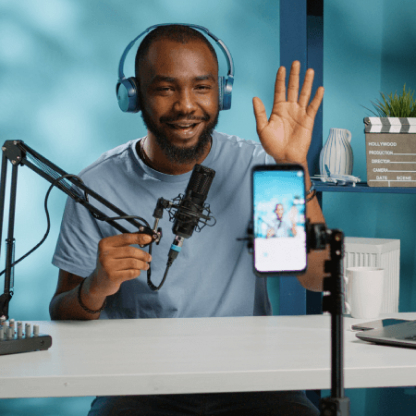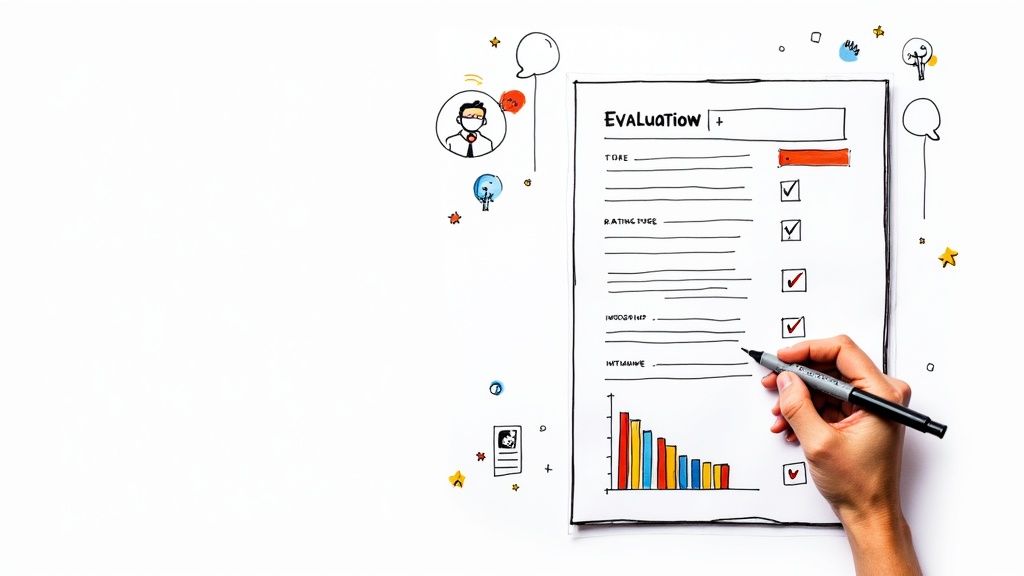Let’s be honest. Your calendar is a nightmare, you’re swimming in a sea of resumes, and the thought of one more 30-minute “get-to-know-you” call feels like a total productivity killer. We’ve all been there.
This is exactly the kind of hiring headache that one-way video interviews were designed to solve. But before you dive in, let's have a real conversation about what they are—and just as importantly, what they aren't.
So, What Is a One Way Video Interview, Anyway?
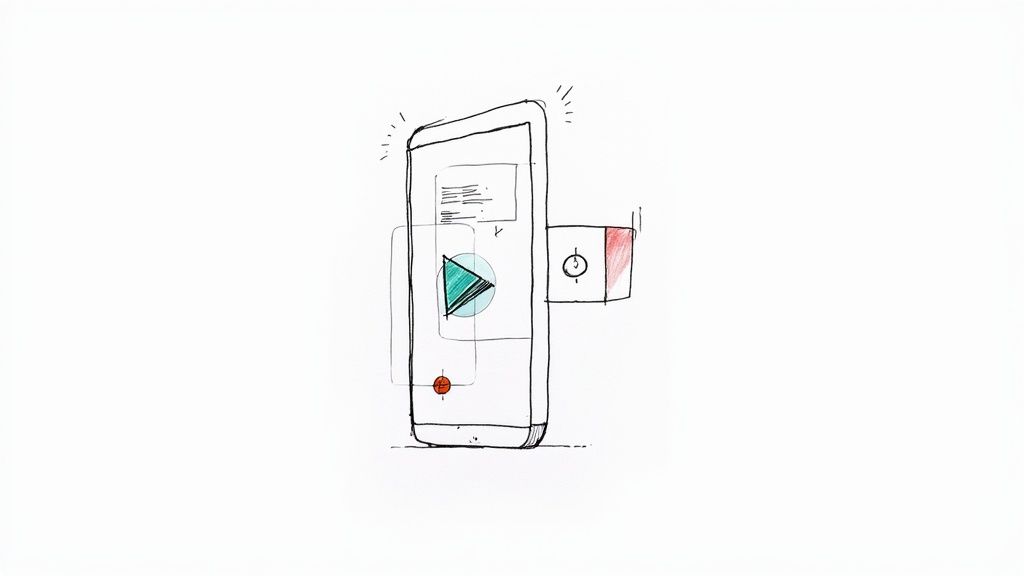
Think of it as a pre-recorded handshake. Instead of a live, back-and-forth conversation, a one way video interview is a screening where candidates answer your questions on their own time, without you or your team being present. It’s a way to get a feel for a candidate's personality and communication style before you commit your team's valuable time to a live call.
This isn’t just another shiny HR tech tool; it's a fundamental shift in how you first meet potential hires. You send candidates a link with your pre-set questions, and they use their own device to record their answers whenever it works for them. No scheduling chaos, no time-zone gymnastics.
The Basic Mechanics
It’s a surprisingly simple, asynchronous process that completely decouples your schedule from the candidate’s. Here’s how it usually plays out:
- You Set the Stage: First, you craft the questions you want candidates to answer.
- They Record: Candidates get a link, have a moment to prepare, and then record their video responses.
- You Review: Your hiring team can then watch the submissions whenever it fits into their day, share notes, and decide who moves to the next round.
This approach has gone from a niche tool to a mainstream practice. Some projections show that by 2025, virtual interviews will be part of 86% of hiring processes worldwide. It’s more than a trend; it’s a reflection of how modern, efficient teams need to operate.
The core idea is simple: reclaim your team’s time by letting technology handle the initial screening. This frees up your senior people for high-value, late-stage interviews, not endless introductory calls.
To really see the difference, let’s put the old way and the new way side-by-side.
Traditional Phone Screen vs One Way Video Interview
This table breaks down how a one-way video interview stacks up against the classic phone screen. It's a quick, no-nonsense look at how this shift can impact your process.
| Aspect | Traditional Phone Screen | One Way Video Interview |
|---|---|---|
| Scheduling | Requires back-and-forth coordination for a live call | Candidate completes on their own schedule |
| Time Commitment | 30-60 minutes of live, dedicated time per candidate | 5-10 minutes to review a recording per candidate |
| Consistency | Questions and conversation can vary between calls | All candidates receive the exact same questions |
| Review Process | Relies on one person's memory and notes | Recordings can be shared and reviewed by the whole team |
| Candidate Flexibility | Limited to specific time slots during business hours | High flexibility, can record anytime, anywhere |
| Visual Cues | None, audio-only | Captures communication style and personality |
As you can see, the benefits in efficiency and consistency are pretty clear.
But is it the right move for your company, or a fast track to alienating your best applicants? We’ll break it all down—minus the corporate jargon—and get into the nitty-gritty. For a deeper dive, check out our guide on unveiling the dynamics of one-way video interviews. This is your first step to deciding if this method is your new secret weapon or a tool better left on the shelf.
The Good, The Bad, And The Awkward
Alright, let's get into the weeds. On paper, the one-way video interview sounds perfect. You save time, screen more people, and do it all without having to find a quiet meeting room. And for your team, that’s largely true.
But it’s not all sunshine and automated workflows. This is a tool, and like any tool, it can be used brilliantly or, well, not so brilliantly. Let's pull back the curtain on the real-world pros and cons—from both sides of the screen.
For You: The Massive Wins
The biggest, most undeniable win is time. Seriously, think about it. Hope you enjoy spending your afternoons fact-checking resumes and running endless 30-minute introductory calls—because that’s now your full-time job. Unless you'd rather let asynchronous video do the initial heavy lifting for you.
Recruiters can slash their time-to-hire by reclaiming hundreds of hours. Instead of the constant scheduling back-and-forth, your team reviews concise, focused answers whenever it’s convenient for them. This brings some game-changing benefits:
- Ruthless Efficiency: You can screen ten candidates in the time it used to take for just two phone calls.
- Global Reach: Your talent pool just exploded. Time zones are no longer a barrier to finding the absolute best person for the job, wherever they might be.
- Consistency is King: Every single candidate gets the same questions in the same format. This creates a level playing field and makes apples-to-apples comparisons shockingly easy, reducing the "gut feeling" bias that so often creeps into live chats.
This isn’t just about making your life easier; it's about making your entire process smarter and more scalable. You’re essentially building a library of first impressions that can be shared, reviewed, and re-evaluated by the whole hiring team.
For Them: The Awkward Reality
Now, let's flip the camera around. For candidates, the experience can be… weird. It often feels like talking to a wall, which is a fantastic skill if you're auditioning for a mime troupe, but not so much for a software engineer.
The candidate perspective is where most companies drop the ball. They forget that this is a person’s first real interaction with their brand. Get it wrong, and top talent will quietly close the tab and move on to the next opportunity.
The candidate experience isn't a "nice-to-have"—it's a core part of your employer brand. A clunky, impersonal process tells candidates you don't value their time or their humanity.
The data backs this up. While nearly 50% of candidates now prefer video interviews for their flexibility, about 25% find the one-way format more stressful than a live conversation. Why? The lack of real-time feedback and genuine human connection is a major factor.
The main pain points for candidates usually boil down to these issues:
- The Performance Pressure: It feels more like an audition than a conversation. This can reward people who are great on camera over those who are truly great at the job.
- The Tech Tango: “Is my mic on? Is the lighting okay? Did that just record?” Technical glitches are a very real source of anxiety.
- The Feedback Void: Candidates record their answers, hit submit, and often hear nothing but silence. It feels like sending your application into a black hole.
For candidates, navigating a one-way video interview is also an exercise in building effective personal branding online, where every visual and verbal cue contributes to their digital identity. This just adds another layer of pressure. Understanding this dynamic is the key to making the process feel fair and respectful—which is the only way you'll get the best out of people. The goal is to maximize the benefits for your team while sidestepping the pitfalls that make great candidates cringe.
How To Implement This Without Messing It Up
So you're sold on the idea. Great. Now, how do you actually roll out a one-way video interview process without it backfiring spectacularly? This is where a lot of companies stumble. They grab the first shiny piece of software they see, blast out a generic template, and then wonder why their candidate pipeline is suddenly a ghost town.
This isn't about just clicking "send" on a new tool. It’s about carefully building a process that’s efficient for your team but also genuinely respectful of the candidate. Let’s be real: a poorly designed process is worse than no process at all. It actively repels the very people you want to hire.
Consider this your step-by-step playbook, written by someone who has learned these lessons the hard way. Forget the corporate jargon; this is pragmatic, in-the-trenches advice to make this work.
Set The Stage Before You Hit Record
First things first: you can't just throw candidates into the deep end. They’re already nervous. Your job is to make them feel as prepared and comfortable as possible, not to test their ability to navigate a confusing interface under pressure.
Start with a crystal-clear welcome message. Explain why you're using a one-way video interview—to be respectful of their time and yours. Tell them what to expect from the process, how long it will likely take, and give them a human touchpoint, like an email for a real person they can contact if they run into a problem.
A little transparency goes a long way. Simply explaining the 'why' behind the process can shift a candidate's perspective from "this is a weird robot test" to "this company values efficiency and my time."
Your goal isn't to catch them off guard. It's to get the most authentic version of them, and that only happens when they aren't panicking about the logistics.
Here’s the basic flow you should communicate to every candidate so they know exactly what’s coming.
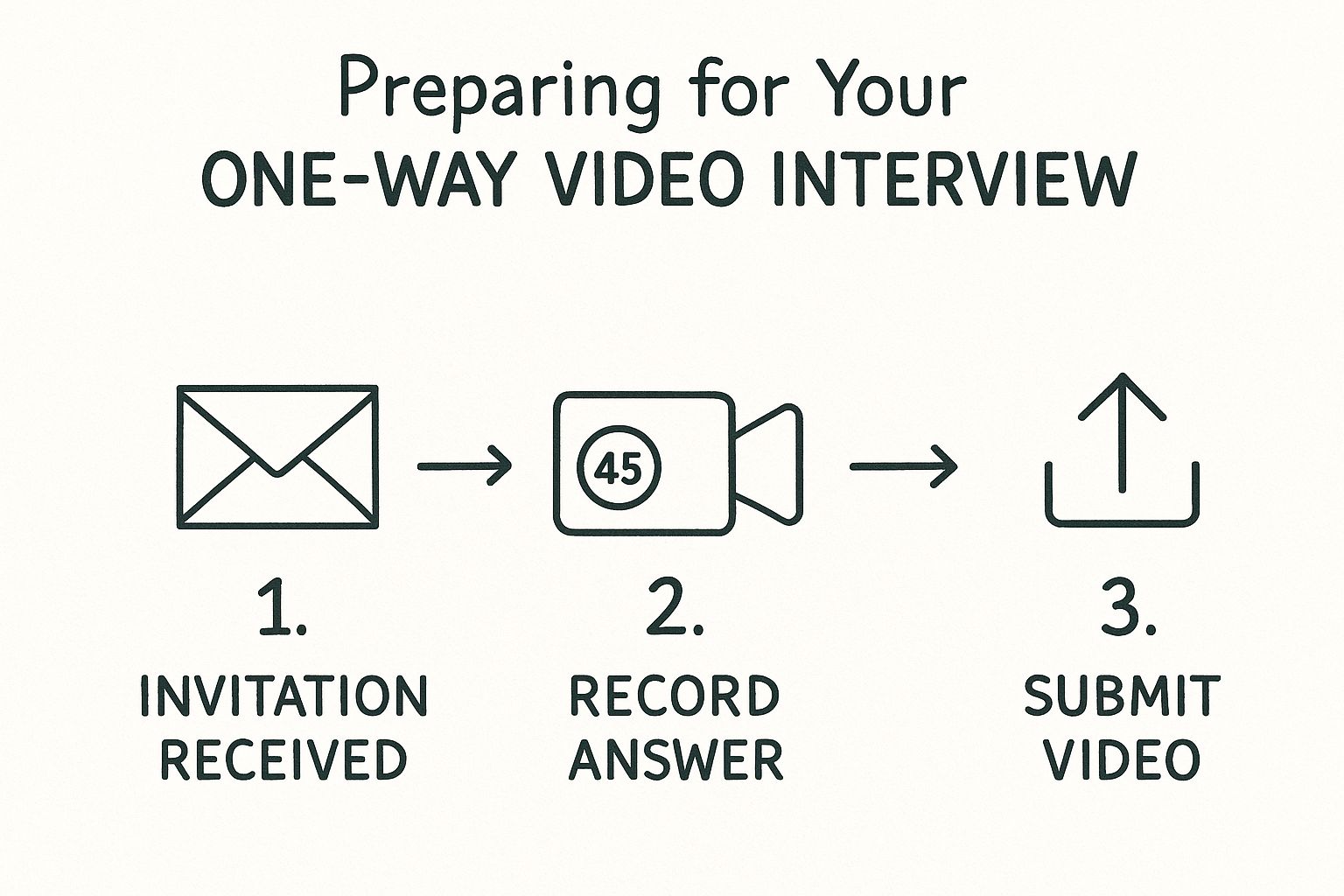
This simple, three-step journey is all the candidate sees, so making it feel smooth and professional is non-negotiable.
The Platform And The Process Matter
Choosing the right software is critical, but don't get sidetracked by shiny objects. The best platform isn't the one with the most AI-powered buzzwords; it's the one that delivers the best candidate experience.
Does it allow for practice questions? Can candidates re-record an answer if they stumble? These aren't just nice-to-have features; they are signals to the candidate that you’re fair and empathetic. Remember, a staggering 61% of candidates have quit an application process because it was too long or complex. Your implementation needs to be ruthlessly simple.
Here are a few key things to get right in your setup:
- Offer Practice Runs: Always give candidates a chance to test their tech and answer a dummy question. This removes a massive layer of anxiety and ensures their first real answer isn't derailed by a microphone issue.
- Allow Re-Records (Within Reason): Give them a second chance. One or two re-record attempts per question is often the sweet spot. It lets them recover from a verbal stumble without letting them script a perfect, robotic answer.
- Set Clear Time Limits: Be upfront about how much time they have to think and how long they have to record. This creates a consistent structure for everyone and makes your review process much easier.
For more in-depth advice on helping your applicants succeed, check out our guide on mastering your on-demand video interview with pro tips for success. A well-prepared candidate gives a better interview, which helps everyone.
Branding It Like You Mean It
Finally, don’t neglect your branding. A one-way video interview that looks like it came from a generic, third-party service feels cold and impersonal. Use a platform that lets you add your company logo, use your brand colors, and maybe even include a personalized welcome video from the hiring manager.
This isn’t just about aesthetics. It’s about reinforcing your employer brand at every single touchpoint. It shows you’re invested in the process and, by extension, in the people going through it. You want candidates to feel like they are applying to your company, not submitting an application to some faceless software bot.
Making the process feel human, even when it's automated, is the secret sauce. Get that right, and you'll turn a potential point of friction into a genuine competitive advantage.
Crafting Questions That Actually Matter
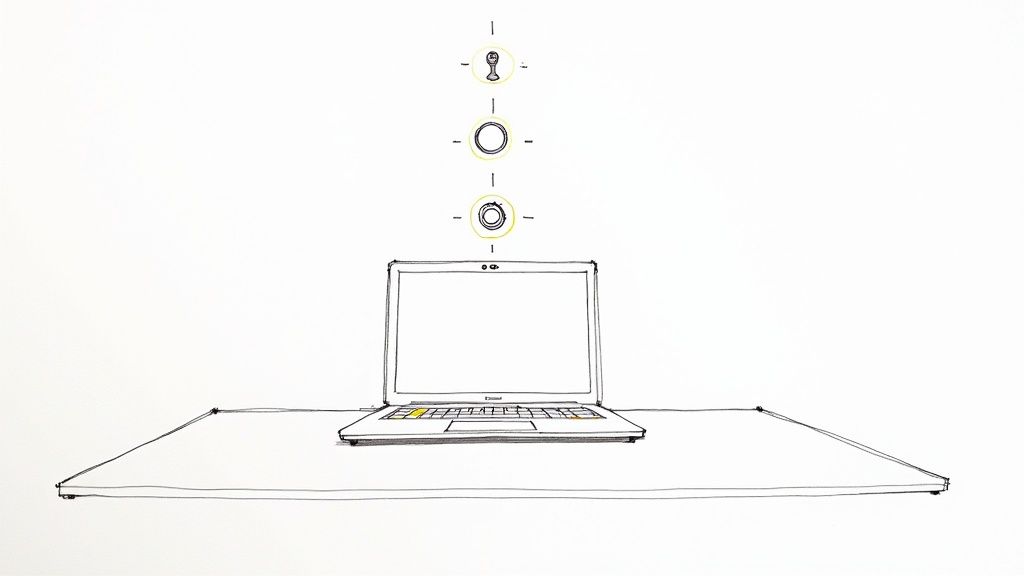
Here’s a secret your generic HR blog won't tell you: the questions you ask in a one-way video interview are completely different from those in a live chat. If you just copy and paste your old phone screen script, you’re wasting everyone’s time.
Asking "Where do you see yourself in five years?" to a camera is a recipe for a canned, rehearsed answer. The candidate has all the time in the world to polish a response that tells you absolutely nothing. This is your chance to get creative, move beyond the resume, and assess the skills that actually matter before you commit a single minute of your team's schedule.
The goal here isn't to replicate a live interview. It's to do something better: get authentic, unfiltered responses that give you a real glimpse into who the candidate is, not just what they wrote on their LinkedIn profile.
Moving Beyond The Obvious
Let's just get this out of the way: if a question can be answered with a quick Google search or by reciting a line from their resume, it’s a bad question for this format. You need prompts that force them to think on their feet.
The asynchronous format is uniquely suited for assessing three key areas that are notoriously hard to judge from a piece of paper:
- On-the-fly problem-solving: How do they react when they don't have a pre-packaged answer?
- Situational judgment: What would they actually do in a real-world scenario your team faces?
- Communication clarity: Can they articulate a complex idea clearly and concisely under a bit of pressure?
These are the things that separate a good hire from a great one. A well-designed one-way video interview is your first and best chance to see them in action.
Your questions are the entire foundation of this process. Weak questions will give you weak signals, and you'll end up advancing the candidates who are best at performing for a camera, not the ones who are best for the job.
Behavioral Questions That Dig Deeper
This is where the classic "Tell me about a time when…" framework really shines, but you have to give it teeth. Vague prompts get vague answers. So, get specific.
Instead of asking, "Tell me about a time you dealt with a difficult customer," try something more pointed:
"Walk me through a specific time a customer was upset about a product flaw you were responsible for. What were the exact steps you took to handle it, what was the outcome, and what would you do differently today?"
This multi-part question forces them to deconstruct a situation, own their part in it, and show reflective thinking. That’s gold. When designing your questions, incorporating behavioral questions can provide deep insights into a candidate's past performance. For specific examples and strategies, explore these common behavioral interview questions and answers to build a robust question set.
The Mini Case Study
This is my personal favorite. Don't just ask if they have a skill; make them use it, right there on camera. You can adapt this for almost any role.
- For a Marketer: "Our latest product launch is seeing lower-than-expected engagement on social media. You have a $500 budget and one week to turn it around. What are the first three things you do? Be specific."
- For a Project Manager: "Imagine two key stakeholders on your project have completely conflicting requirements. You can't satisfy both. How do you decide which direction to take and how do you communicate that decision?"
- For a Developer: "Walk me through the process of how you would debug a critical, user-reported bug in a live application. Assume you have access to logs and monitoring tools. What's your thought process?"
These aren't "gotcha" questions. They're small, practical tests that simulate the real challenges of the job. You'll learn more from a two-minute answer to one of these than from a 30-minute chat about their career goals. They reveal how someone thinks, and in the end, that's what you’re hiring.
How The Right Tech Makes This Work
Let's get real for a moment. We didn't just stumble into building a solution. We built one because we were genuinely fed up with the clunky, impersonal tools out there—the kind that feel like they were designed by people who’ve never actually hired anyone. So yes, consider this a peek under the hood at how a purpose-built tool can solve the very real problems we’ve been talking about. (Toot, toot!)
To be brutally honest, the entire concept of a one-way video interview lives or dies by the technology behind it. A bad platform makes you look amateurish and immediately alienates top-tier candidates. But the right tech? It can shift this process from a necessary evil into a genuine competitive advantage.
From Clunky And Cold To Efficient And Human
For too long, HR tech was built for process, not for people. It was all about ticking boxes. We think that’s completely backward. The best technology should practically disappear, creating a seamless experience for the candidate while giving your team powerful, intuitive tools.
This is where the theory meets the road. We've talked about what a good process looks like; now let's see how smart features bring it to life. The goal is to build a hiring machine that’s both ruthlessly efficient and surprisingly human.
Here’s what that looks like in the real world:
- Customizable Branding: The interview needs to feel like it’s coming from your company, not some random third-party service. Adding your logo and brand colors isn't just window dressing; it's a critical touchpoint that builds trust and professionalism from the start.
- Candidate-Friendly Instructions: Don't leave your candidates guessing. Clear guidance, welcome videos from the team, and a chance to do practice questions all work together to demystify the process and lower their anxiety.
- Seamless ATS Integration: Your hiring tools have to talk to each other. A platform that plugs directly into your Applicant Tracking System (ATS) saves you from the soul-crushing admin work of manually shuttling data back and forth.
It’s All About Speed And Smarter Decisions
Let's talk about efficiency, because it's not just a buzzword—it's a measurable result. A recent survey found that 45% of recruiters agree that video interviews speed up the hiring process. This is no surprise to anyone who's escaped the scheduling black hole of endless phone screens. The acceleration comes from the asynchronous model, which lets your team review candidates on their own time. If you want to dive deeper, you can explore more data on how video interviews impact hiring timelines.
A great platform doesn’t just record videos; it helps you make better decisions, faster. It surfaces the best candidates and gives your team the collaborative tools needed to spot talent with confidence.
Many platforms are now bringing AI into the mix to give you an even greater edge. These systems can provide automated transcriptions, making it a breeze to search for keywords or review answers without re-watching an entire video. One-way video interview platforms frequently incorporate AI to streamline candidate assessment. To get the full picture on the broader impact of AI in modern recruitment processes, it's worth seeing how these tools are changing the game beyond just video screenings.
At the end of the day, the right tech gets out of the way. It empowers you to focus on what truly matters: finding the right people for your team. Turns out there’s more than one way to hire without mortgaging the office ping-pong table. We’re not saying we’re perfect. Just more accurate more often.
The Verdict: Is This Your New Secret Weapon?
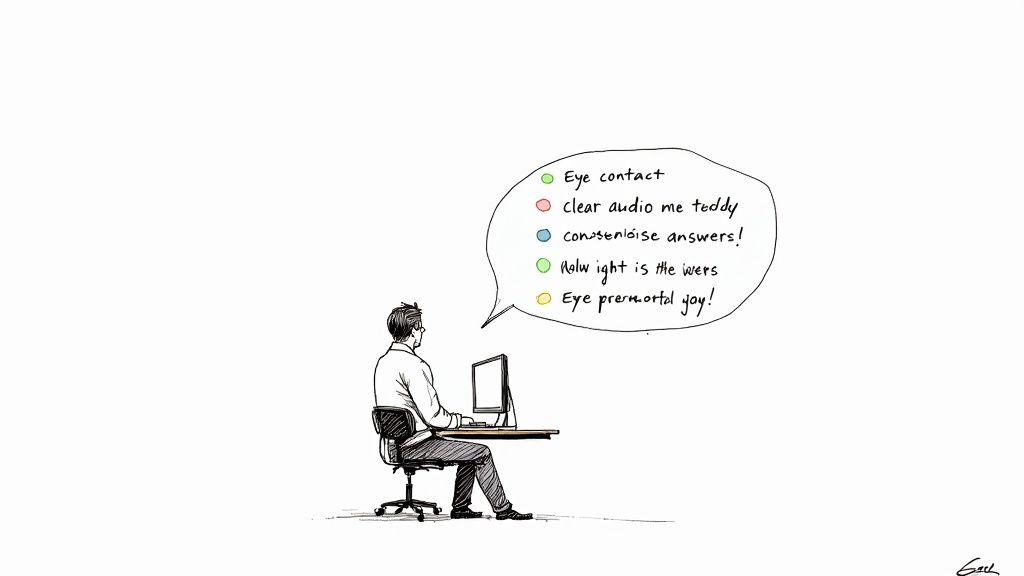
So, we’ve walked through the good, the bad, and the sometimes awkward world of asynchronous interviews. What’s the final takeaway? Is the one-way video interview truly the future of hiring, or is it just another piece of tech destined for the HR graveyard?
The honest answer: it’s a tool. A powerful one, at that. But like any tool, it can be used to build a bridge or smash a window. It all depends on how you use it.
Get it wrong, and you risk creating a cold, robotic process that pushes away the very talent you’re trying to attract. But get it right—with a clear strategy, a dose of empathy, and the right technology—and it can be an absolute game-changer for your hiring.
A Weapon or a Weakness?
A well-designed asynchronous process is about more than just saving time; it's about hiring smarter. It completely levels the playing field for candidates in different time zones, gives you a consistent and fair framework for evaluation, and helps you spot those hidden gems who might have been missed in a quick phone screen.
The real difference between success and failure boils down to one simple thing: intent. Are you using this technology to filter people out, or to find the best people and let them in?
Think of it this way: A one-way video interview shouldn't be a robotic hurdle. It should be a welcoming front door that gives every candidate a fair and equal chance to make their case, on their own terms.
That shift in mindset is what makes all the difference. To get there, you have to nail the fundamentals.
Your Final Checklist for Success
Before you jump in headfirst, ask yourself if you’re really ready. Are you prepared to do the work needed to make this a genuinely positive experience for your candidates?
- Human-First Communication: Will you clearly explain why you're using this format and what candidates can expect?
- Thoughtful Questions: Have you designed prompts that test for real skills and problem-solving, not just on-camera charisma?
- Candidate-Friendly Tech: Does your platform give candidates a chance to practice and re-record their answers?
- A Clear Feedback Loop: Do you have a plan to keep every candidate informed and close the loop respectfully, regardless of the outcome?
If you can confidently say "yes" to these questions, you're not just adopting a new tool; you're building a smarter, more effective hiring engine. For more insights on this approach, explore our guide to smart hiring with one-way and on-demand asynchronous interviews.
Ultimately, the one-way video interview is exactly what you make of it. It can be your new secret weapon, helping you build a world-class team with incredible speed and precision. Just remember to handle it with care.
Your One-Way Video Interview FAQs, Answered
Alright, let's get into the nitty-gritty. If you're still on the fence, you probably have a few lingering questions. I’ve heard them all, so here are the straight-up answers—no fluff, just what you need to know from someone who’s been in the trenches.
Are One-Way Video Interviews Legal and Fair?
This is a big one, and the short answer is yes, they are perfectly legal. The real question is about fairness, and that comes down to how you use them.
The key is consistency. When you ask every single candidate the exact same set of questions in the same format, you're actually creating a more standardized and objective baseline than you could ever get from a series of unscripted phone calls. It’s a powerful way to level the playing field.
But that fairness falls apart if your questions are biased or if your process doesn't accommodate candidates who might need assistance. The goal isn't to create new hurdles; it's to remove old ones. Done right, this format can seriously reduce the "gut feeling" bias that plagues so much of traditional hiring.
The real risk isn't the technology itself; it's a poorly designed process. If you're using it as an excuse to be lazy or impersonal, you're doing it wrong.
How Long Should a One-Way Video Interview Be?
Keep it short. Seriously. Remember, this is a top-of-funnel screening tool, not the final round. Your only mission here is to gather just enough information to decide who moves on.
A good rule of thumb is 3-5 questions, with each answer capped at 1-2 minutes. This keeps the total commitment for the candidate under 15 minutes, which is respectful of their time. Push it any longer, and you’ll start seeing a major drop-off in completion rates, especially from top talent who have plenty of other options.
What if Candidates Hate It?
Let's be honest: some will. The experience can feel a bit awkward, especially for people who aren't used to talking to their camera. While research shows that almost half of candidates love the flexibility, about a quarter find it more stressful than a live conversation.
You can't eliminate the awkwardness entirely, but you can absolutely minimize it. Here's how:
- Explain the Why: Briefly tell them you're using this format to respect their schedule and give everyone an equal shot. A little transparency goes a long way.
- Offer a Practice Round: Let candidates test their tech and warm up with a practice question. It's a small gesture that dramatically reduces anxiety.
- Keep it Human: A short, authentic welcome video from the hiring manager can make the whole thing feel less like an audition for a robot and more like a real human interaction.
Your aim isn't to convert every single skeptic. It’s to run a process that’s fair, transparent, and professional enough that even the people who find it awkward still walk away feeling respected.
Ready to see how a one-way video interview process can be ruthlessly efficient and surprisingly human? Async Interview gives you the tools to find top talent up to ten times faster, without losing the personal touch. Start your free trial today and see the difference.
